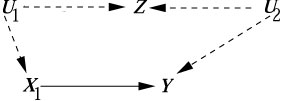CAUSALITY - Discussion (Yudkowsky)
Date: April 24, 2006
From: Eliezer S. Yudkowsky, Research Fellow, Singularity Institute
for Artificial Intelligence, Santa Barbara, CA
Subject: The validity of G-estimation
Question to author:
The following paragraph appears on p. 103, shortly after eq. 3.63 in
my copy of Causality:
"To place this result in the context of our analysis in this chapter, we note
that the class of semi-Markovian models satisfying assumption (3.62)
corresponds to complete DAGs in which all arrowheads pointing to Xk originate
from observed variables."
It looks to me like this is a sufficient, but not necessary, condition to
satisfy 3.62. It appears to me that the necessary condition is that no
confounder exist between any Xi and Lj
with i < j and that no confounder
exist between any Xi and the outcome variable Y.
However, a confounding arc between any Xi and
Xj, or a confounding arc between Li and
Xj with i <= j,
should not render the causal effect non-identifiable. For example,
even if a confounding arc exists between X2
and X3 (but no other confounding arcs
exist in the model), the causal effect on Y of setting
X2=x2 and
X3=x3
should be the same as the distribution on Y if we observe x2 and x3.
It is also not necessary that the DAG be complete.
Author reply:
You are right that the DAG need not be complete,
and that the condition cited in p. 103 is sufficient
but not necessary for either
(3.62)

or the G-estimation
formula
(3.63)

to hold. Corrections
to the wordings of page 103 were posted on this website.
Your suggestion to allow confounding arcs beween
Xi and Xj, is valid. However,
allowing a confounding arc between Li and
Xj (with i < j) is too permissive,
as can be seen by the non-identified models of Figure
3.9 (b), (c), (d) and (g) in Causality.
In general, condition (3.62) is both over-restrictive and lacks
intuitive basis. A more general and intuitive condition leading to
(3.63) is formulated in (4.5) (Causality, p 122), which reads
as follows:
(3.62*) General condition for g-estimation
P(y|g = x) is identifiable and is
given by (3.63) if every action-avoiding back-door path from
Xk to Y is blocked by some subset
Lk of non-descendants of Xk.
(By "action-avoiding" we mean a path containing no arrows entering
an X variable later than Xk.)
Comment 1: The new definition leads to improvements over (3,62), namely,
there are cases where the g-formula (3.63) is valid with a subset
Lk of
the past but not with the entire past.
Example 1:

Assuming U1 and U2 are unobserved,
and temporal order: U1,Z, X1,
U2,Y we see that (3.62*), hence (3.63), are
satisfied with L1 = 0, while taking the whole past
L1 = Z would violate both.
(3.62) is also satisfied with the choice L1=0, but not
with L1=Z.
Comment 2: Defining Lk as the set of
"nondescendants" of Xk (as opposed to temporal
predecessors of Xk) also broadens (3.62).
Example 2:

with temporal order: U1,X1, S,Y
Both (3.62) and (3.62*) are satisfied with L1 = S,
but not with L1 = 0.
Comment 3: There are cases where (3.62) will not be satisfied even with the
new interpretation of Lk, but the graphical
condition (3.62*) is.
Example 3: (constructed by Ilya Shpitser)

It is easy to see that (3.62*) is satisfied; all back-door
action-avoiding paths from X1 to Y are
blocked by X0, Z, Z'.
At the same time, it is possible to show, though by a rather
intricate method (see the Twin Network Method, page 213) that
Y{x1, x2}
is not independent of X1,
given Z, Z' and X0.
(In the twin network model there is a d-connected path from
X1 to Yx, as follows:
X1 <--> Z <--> Z* --> Z'* --> Y*)
Therefore, (3.62) is not satisfied for
Y{x1,x2} and
X1.)
This example demonstrates one weakness of the Potential Response
approach initially taken by Robins in deriving (3.63). The counterfactual
condition (3.62) that legitimizes the use of the g-estimation
formula is void of intuitive support, hence, epidemiologists
who apply this formula are doing so under no guidance of substantive
medical knowledge. Fortunately, graphical methods are slowly making
their way into epidemiological practice, and more and more
people begin to understand the assumptions behind g-estimation.
(Warning: Those who currently reign causal analysis in statistics
are incurably graph-o-phobic and ruthlessly resist attempts to enlighten
their students, readers and co-workers with graphical methods. This
slows down progress in statistical research, but will eventually be overrun by
commonsense.)
Next discussion (CS262Z: Identifying conditional plans
Return to Discussions




